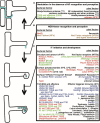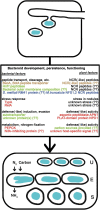Varietas Delectat: Exploring Natural Variations in Nitrogen-Fixing Symbiosis Research
- PMID: 35481136
- PMCID: PMC9037385
- DOI: 10.3389/fpls.2022.856187
Varietas Delectat: Exploring Natural Variations in Nitrogen-Fixing Symbiosis Research
Abstract
The nitrogen-fixing symbiosis between leguminous plants and soil bacteria collectively called rhizobia plays an important role in the global nitrogen cycle and is an essential component of sustainable agriculture. Genetic determinants directing the development and functioning of the interaction have been identified with the help of a very limited number of model plants and bacterial strains. Most of the information obtained from the study of model systems could be validated on crop plants and their partners. The investigation of soybean cultivars and different rhizobia, however, has revealed the existence of ineffective interactions between otherwise effective partners that resemble gene-for-gene interactions described for pathogenic systems. Since then, incompatible interactions between natural isolates of model plants, called ecotypes, and different bacterial partner strains have been reported. Moreover, diverse phenotypes of both bacterial mutants on different host plants and plant mutants with different bacterial strains have been described. Identification of the genetic factors behind the phenotypic differences did already and will reveal novel functions of known genes/proteins, the role of certain proteins in some interactions, and the fine regulation of the steps during nodule development.
Keywords: legume ecotypes/cultivars; partner dependent mutation manifestation; rhizobium strains; symbiotic incompatibility; symbiotic nitrogen fixation.
Copyright © 2022 Wang, Balla, Kovács and Kereszt.
Conflict of interest statement
The authors declare that the research was conducted in the absence of any commercial or financial relationships that could be construed as a potential conflict of interest.
Figures


References
-
- Ardourel M., Demont N., Debellé F., Maillet F., De Billy F., Prome J. C., et al. (1994). Rhizobium meliloti lipooligosaccharide nodulation factors: different structural requirements for bacterial entry into target root hair cells and induction of plant symbiotic developmental responses. Plant Cell 6 1357–1374. 10.1105/tpc.6.10.1357 - DOI - PMC - PubMed
-
- Bergersen F. J., Nutman P. S. (1957). Symbiotic effectiveness in nodulated red clover. IV. the influence of the host factors i1 and ie upon nodule structure and cytology. Heredity 11 175–184. 10.1038/hdy.1957.15 - DOI
Publication types
LinkOut - more resources
Full Text Sources

